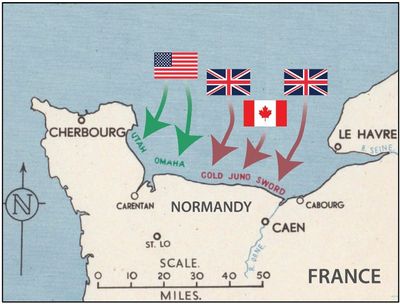The Setting for the Landing...

Forces massed in England
More than 150,000 personnel, spread across southern Britain, arrayed for both tactical effectiveness and deception.
A crossing timed to the lunar cycle
Only two nights in the entire month of June were suitable, with the desired tidal conditions and lunar lighting
An attack in darkness, carried through night into morning
Airborne troops off course at night, missing or losing geographical reference points. Amphibious forces first landing just after midnight. It was to be a very, very long first day.
Vastly different levels of resistance, based on location
Because of the effectiveness of deception operations, beach defenses were neither uniform nor aligned well to the Allied attack. As a result, casualties in certain areas were dramatically higher than in others.

Americans to the West, British and Canadian forces to the East
Sword and Juno Beaches tasked to British forces, with Juno in the middle the responsibility of the Canadians. To the West, Utah and Omaha were the responsibility of the Americans.
Stout German fortifications - the "Atlantikwall"
German forces were filly dug in, with a vast network of concrete pillboxes, hardened artillery positions, ammunition storage capability, and fortified tunnels,
Moments in the history of D-Day
In an amphibious landing operation involving more than 150,000 personnel, we find it important to recognize and remember the small teams and individual heroes who helped ensure the success of the Allies on that day. You will see a new story here monthly, hung on what we call our "Knowledge Wall". The schedule is at the bottom of the page.
Click into our January entry and sign up for regular updates here.
2025 Knowledge Wall Schedule
1/5/2025
Operation Postage Able
1/5/2025
Operation Postage Able
In January 1944, five men traveled in a 51-foot X-craft midget submarine to Nazi-occupied France. These forgotten heroes were critical to t...
2/1/2025
Operation Fortitude (South)
2/1/2025
Operation Fortitude (South)
The Allied Deception Campaign vs. Nazi Germany
3/1/2025
The First Newsreels of D-Day
3/1/2025
The First Newsreels of D-Day
The Guardian UK
4/1/2025
Why Canada Mattered on D-Day
4/1/2025
Why Canada Mattered on D-Day
Canadian forces and their central role on the D-Day landing front
5/1/2025
A Tough Fight on Gold Beach
5/1/2025
A Tough Fight on Gold Beach
The extreme challenge for the British on D-Day
Copyright © 2025 Endurance Challenge Normandie - All Rights Reserved. info@endurancechallenge.org
This website uses cookies.
We use cookies to analyze website traffic and optimize your website experience. By accepting our use of cookies, your data will be aggregated with all other user data.